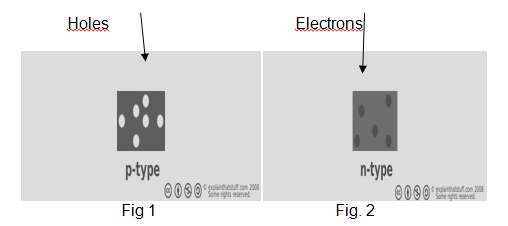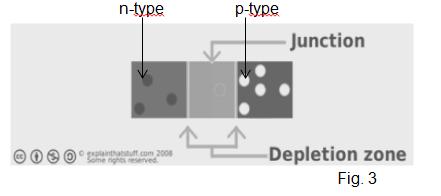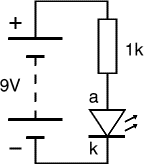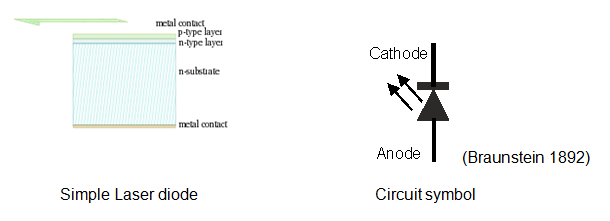Introduction
Electroluminescence is the brainchild of Round, a British experimenter, who first employed the use of a “crystal silicon carbide and a cat’s-whisker detector to produce light in the year 1907” (Braunstein 1891). Through a span of 2 decades of revolution of Round’s principle, the first LED was made. By the early 1970s revolutions had seen the development of LEDs capable of emitting entirely all the visible spectrum and, brighter. However, until then, these devices were costly. To date, the current cheap LEDs available in the market are owed to Brandt an optoelectronics pioneer.
LEDs find applications in many electric and electronic devices. Some of these electric devices include indicator lamps, traffic signals, advertisement lighting, automotive and aviation lighting. In electronics among other applications, it is used in remote controls, calculators, televisions as well as DVD players.
Emissions from LED are normally incoherent vis-a-vis Laser diode emission. In other words, the development of a more coherent source of light typical of Laser diode emission was first developed in the early 1960s by a duo US group led by Hall and Nathan. The years that followed saw to it the evolution of Laser diodes from mono to heterojunctions enhancing significant reduction of the threshold current of emission at room temperatures.
However, the major hindering factor concerning Lasers of the then era was that they “were unable to function in continuous-wave operation at room temperature” (Iga 1210). The innovation of a double heterojunction diode in the year 1970 overcame the challenge posed by its’ predecessor model. As such, a double heterojunction presented a perfect initial example of ‘Nanotechnology.’
Laser diodes find applications in telecommunication, barcode readers, CD players, DVDs, CD-ROMs, HD DVDs and, LAS (Laser Absorption Spectrometry).
Semiconductor
Both light-emitting diode (LED) and Laser Diode have one thing in common; they both use a semiconductor to emit light. By definition, a semiconductor is an intermediate device between a conductor and an insulator. Semiconductors have conductivity ranging roughly between 103 and 10-8 S/cm. The discovery of a semiconductor marked a major milestone in contemporary electronics that encompasses among other devices computers, radios, and telephones.
Structurally, a semiconductor is a solid chemical compound that, depending on the condition, may or may not conduct electricity. As such, this device presents a perfect tool for electric and electronic fraternity for controlling electric current. A semiconductor’s ability to conduct electricity depends on the size of current or voltage, or the strength of the radiation applied.
Semiconductors are classified into two major groups depending on the chemical composition. A pure and natural semiconductor otherwise known as an intrinsic semiconductor has no impurities (dopant). A perfect example is a silicon (Group IV elements) element that has electric conductive ability at any temperatures above absolute zero permitting small currents. On the other hand, an extrinsic semiconductor is a synthetic semiconductor formed by doping an intrinsic semiconductor with either a Group III element or a Group V element. The former results in the formation of a p-type (positive type) semiconductor while the later result in an n-type (negative type) semiconductor. In essence, p-type means that majority charge carriers are positive holes (Fig. 1) owing to deficiency in electrons after doping.
The opposite is true for an n-type semiconductor which results in excess electrons (Fig. 2); the majority charge carriers. Some examples of extrinsic semiconductors include indium antimonide, gallium arsenide, and majority metallic oxides. With this ability, an extrinsic semiconductor, typically a microprocessor chip, presents an efficient tool substituting a vacuum tube which is voluminous and costly (Saleh and Teich 19).

As the name suggests an LED and a Laser diode are chiefly diodes. Principally, a diode is a product of a combination of an n-type and a p-type diode that results in the formation of a p-n junction. Whatever happens whenever these two diodes combine is that the holes and electrons from either side diffuse a cross the junction thus forming a region at the center devoid of free holes and electrons. This region, also known as a depletion layer, forms a barrier for electric conductivity. This is represented as is in the figure below (Fig. 3) (Braunstein 1888).

When the terminals of a battery are connected such that the positive terminal is connected to the p-type and the negative connected to the n-type i.e. forward-bias, whatever transpires is a shrink in the depletion layer (Fig. 4). As such, it allows electric current to flow. The opposite, a reverse-biased connection, results in the widening of the depletion layer (Fig. 5) thus hindering transfer of electric current. Hence, a diode can be described as an electric one-way device permitting current only when forward biased (Braunstein 1889).

Light-emitting diode (LED)
An LED is an electronic device which uses the principal of a diode to emit light once a current is injected through it. These devices come in varying physical styles which enable them to emit light though has a narrow color spectrum. An LED has a limiting voltage beyond which it breaks down. These limiting voltages vary from one LED to another. For instance, for amber, green, yellow and red color emitting LEDs the breakdown voltage is 1.8 V. This is different from a blue emitting diode which has a 3.7 V. breakdown voltage. Noteworthy, LEDs may come in as a multi-colour or, as a white color emitting type. Significantly, the housing plastic material is always lens-shaped either to focus or spread the emerging beam effectively (Moreno and Sun 1811).
The below diagrams represent an example of the device and its circuit symbol.

Device Circuit symbol
Sometimes the anode and the cathode can be represented as letters ‘a’ and ‘k’ respectively. When connecting the device, the anode is always connected to the positive terminal of the battery while the cathode is connected to the negative terminal. Of note, as a precaution when testing the device, the connection is normally connected in series with a high value resistor lest the device breaks down owing to an initially high current. The diagram below represents a schematic circuit diagram of how the connection may be achieved.

How an LED works
Introduction
Electroluminescence is the brainchild of Round, a British experimenter, who first employed the use of a “crystal silicon carbide and a cat’s-whisker detector to produce light in the year 1907” (Braunstein 1891). Through a span of 2 decades of revolution of Round’s principle, the first LED was made. By the early 1970s revolutions had seen the development of LEDs capable of emitting entirely all the visible spectrum and, brighter. However, until then, these devices were costly. To date, the current cheap LEDs available in the market are owed to Brandt an optoelectronics pioneer.
LEDs find applications in many electric and electronic devices. Some of these electric devices include indicator lamps, traffic signals, advertisement lighting, automotive and aviation lighting. In electronics among other applications, it is used in remote controls, calculators, televisions as well as DVD players.
Emissions from LED are normally incoherent vis-a-vis Laser diode emission. In other words, the development of a more coherent source of light typical of Laser diode emission was first developed in the early 1960s by a duo US group led by Hall and Nathan. The years that followed saw to it the evolution of Laser diodes from mono to heterojunctions enhancing significant reduction of the threshold current of emission at room temperatures. However, the major hindering factor concerning Lasers of the then era was that they “were unable to function in continuous-wave operation at room temperature” (Iga 1210). The innovation of a double heterojunction diode in the year 1970 overcame the challenge posed by its’ predecessor model. As such, a double heterojunction presented a perfect initial example of ‘Nanotechnology.’
Laser diodes find applications in telecommunication, barcode readers, CD players, DVDs, CD-ROMs, HD DVDs and, LAS (Laser Absorption Spectrometry).
Semiconductor
Both light-emitting diode (LED) and Laser Diode have one thing in common; they both use a semiconductor to emit light. By definition, a semiconductor is an intermediate device between a conductor and an insulator. Semiconductors have conductivity ranging roughly between 103 and 10-8 S/cm. The discovery of a semiconductor marked a major milestone in contemporary electronics that encompasses among other devices computers, radios, and telephones.
Structurally, a semiconductor is a solid chemical compound that, depending on the condition, may or may not conduct electricity. As such, this device presents a perfect tool for electric and electronic fraternity for controlling electric current. A semiconductor’s ability to conduct electricity depends on the size of current or voltage, or the strength of the radiation applied.
Semiconductors are classified into two major groups depending on the chemical composition. A pure and natural semiconductor otherwise known as an intrinsic semiconductor has no impurities (dopant). A perfect example is a silicon (Group IV elements) element that has electric conductive ability at any temperatures above absolute zero permitting small currents. On the other hand, an extrinsic semiconductor is a synthetic semiconductor formed by doping an intrinsic semiconductor with either a Group III element or a Group V element. The former results in the formation of a p-type (positive type) semiconductor while the latter result in an n-type (negative type) semiconductor.
In essence, p-type means that the majority charge carriers are positive holes (Fig. 1) owing to deficiency in electrons after doping. The opposite is true for an n-type semiconductor which results in excess electrons (Fig. 2); the majority charge carriers. Some examples of extrinsic semiconductors include indium antimonide, gallium arsenide, and majority metallic oxides. With this ability, an extrinsic semiconductor, typically a microprocessor chip, presents an efficient tool substituting a vacuum tube which is voluminous and costly (Saleh and Teich 19).

How a Laser diode works
As stated before, laser diodes take the LED technology an octave high with the objective of producing increasingly pure and powerful beams. To achieve these capabilities, a laser diode makes use of an aluminum alloy together with but not limited to gallium arsenide to emit light. Whatever transpires is that an electron injected into a diode interacts with the hole akin to an electron transiting to a lower energy level in an atom emitting excess energy as a photon (spontaneous emission). This excess energy consequently interacts with extra electrons received to produce more and more photons (stimulated emission) eventuating in a self-perpetual process otherwise known as resonance. The diagram below shows how ‘lasing’ is achieved using a laser diode (Saleh and Teich 23).

Vitally, the emitted ray undergoes continuous repetitive reflection at the junction otherwise known as Fabry-Perot resonance cavity emerging out through a lens as a pure and parallel beam.
Advantages and disadvantages of Laser diodes
One advantage of laser diodes is that they have a high degree of directionality. Also, the emergent light prevails longer owing to a common wavelength and phase of an emerging beam. The advantages of an LED are enhanced by a Laser diode. On the other hand, one disadvantage of Laser diodes is that they are susceptible to aging losing their efficacy. Also, they are sensitive to power fluctuations putting them at risk of damage under varying currents.
Conclusion
In a synopsis, both LEDs and Laser diodes emit light primarily using the same mechanism nevertheless; the later device further utilizes the energy gained initially to stimulate the production of subsequent photons which emerge as pure and concentrated (coherent) beam. The former device produces incoherent beams owing to differences in the phase of the light waves produced. As such, their unique characters suit different applications in electrical and electronic spheres.
Works Cited
Braunstein, Rubin. “Radiative Transitions in Semiconductors”. Physical Review 9. 6 (1955): 1892. Print.
Iga, Kenichi. “Surface-emitting laser—Its birth and generation of new optoelectronics field.” IEEE Journal of Selected Topics in Quantum Electronics 6. 6 (2000): 1201–1215. Print.
Moreno, Ivan, and Sun, Ching-Cherng. “Modeling the radiation pattern of LEDs”. Optics Express 16. 3 (2008): 1808–19. Print.
Saleh, Bahaa, and Teich, Carl. Fundamentals of Photonics. New York: John Wiley & Sons, 1991. Print.